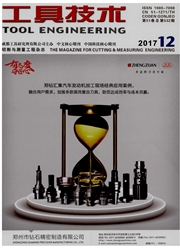

 中文摘要:
中文摘要:
进行光学玻璃BK7超声振动辅助磨削试验,采用截面抛光法配合HF酸腐蚀法并通过扫描电子显微镜观测获得亚表面裂纹的最大深度,研究了主轴转速、磨削深度、进给速度和超声振动振幅对亚表面损伤裂纹最大深度的影响规律,分析了亚表面裂纹的几种形态及其成因。结果表明,随着主轴转速和超声振动振幅增大,磨削深度及进给速度减小,亚表面最大裂纹深度明显减小。超声振动的引入改善了磨削时的加工条件,对提高加工表面及亚表面的质量有一定帮助。
 英文摘要:
英文摘要:
The uhrasonic assisted grinding (UAG) tests of optical glass BK7 are carried out. The maximum depth of subsurface cracks is measured by cross-section polishing and HF etching method with SEM. The influence rules of spindle speed ,feed speed, grinding depth and ultrasonic vibration amplitude on the maximum of subsurface cracks are obtained based on experimental results. Meanwhile, the morphologies and cause of formation of subsurface cracks are analyzed. The experimental and analytical results show that the maximum depth of subsurface cracks is decreased obviously with increase of spindle speed and ultrasonic vibration amplitude and a decrease in feed speed and grinding depth. The introduction of ul- trasonic vibration into the grinding process improves machining conditions, which is helpful to improve the machined surface and subsurface quality.
 同期刊论文项目
同期刊论文项目
 同项目期刊论文
同项目期刊论文
 期刊信息
期刊信息
